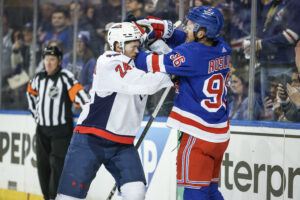Welcome to Last Word on Hockey’s 2021 NHL Draft Class introductions. The 2020 Draft class was a blast, and the 2021 NHL draft should be too. Alexis Lafreniere was the first overall pick for the New York Rangers in ‘20, but who will it be in ‘21? How about we here at Last Word introduce two names to pay attention to this season: Cole Sillinger and Zachary L’Heureux.
2021 Draft Class Introductions: Who To Watch This Season
Every year, the CHL produces an insane amount of talent to rise up into the NHL ranks. Last year, the QMJHL represented the first overall pick, in the form of Alexis Lafreniere. Meanwhile, Quinton Byfield was the second overall selection, representing the OHL. Seth Jarvis, Kaiden Guhle and Braden Schneider were a few WHL representatives in 2020, while Kirby Dach of the Chicago Blackhawks and Bowen Byram of the Colorado Avalanche were 2019’s top reps for the WHL. This year, Zachary L’Heureux is looking to follow Lafreniere through the QMJHL ranks, while Cole Sillinger looks to follow in the footsteps of the several strong prospects taken in recent years.
2021 Draft Class Introductions: Zachary L’Heureux
L’Heureux, born on May 15th, 2003, in Montreal, Quebec, Canada, is a 17-year-old center. He stands at 5’11” and 196 pounds, playing for the Halifax Mooseheads in the QMJHL. He has been ranked 11th by Future Considerations and Dobber Prospects, 26th by Neutral Zone, 22nd by Recruit Scouting, 14th by Draft Prospects Hockey, 13th by Smaht Scouting, and 18th by Bob McKenzie. I personally rank him 26th.
In 2019-20, L’Heureux made himself known in the QMJHL immediately. In his rookie season, L’Heureux scored 20 goals and 33 assists for 53 points in 55 games, just shy of a point per game average. 17 of his 20 goals came at even-strength, per Pick224, and 34 of his points were primary. That said, with his early impact at even-strength and limited power-play time, L’Heureux was looking towards a huge draft year.
From a production stand-point, L’Heureux has come through. In just 12 games, he has scored 7 goals and 6 assists for 13 points. So, why is he ranked so low on my draft board?
Zachary L’Heureux’s Overall Game
L’Heureux is one of the most interesting prospects I’ve seen. Highly lauded by many respected people like Sam Tirpak of Dobber Prospects, who went as far as ranking him 1st in his preseason rankings, it was no secret that eyes would be on the Montreal native. He has quite simply not delivered, at least for me.
However, let’s start with the positives. L’Heureux has incredible awareness and anticipation. The puck always seems to find him, regardless of the situation. When he gets the puck offensively, he gets the puck into high-danger areas. In one game I tracked, he had 17 pass attempts in the offensive zone. He completed just 12 of them, however, making his accuracy a 70.6% mark, easily the lowest among 2021 eligibles I’ve tracked so far. However, his creativity and unpredictability make him a threat when passing the puck. While 10 of his passes were deemed “simple”, he tacked on five centering pass attempts, one cross-ice pass and one cycle pass attempt. He consistently looks to send the puck into the slot, though I want to see him connect on more passes.
When it comes to shooting, L’Heureux had six shot attempts, with three hitting the net. None went in. What is positive, similar to his passing tendencies, is that he had two shots from the slot area. Seeing him attack the slot with his passing and shooting is absolutely a positive.
Transitional Game
L’Heureux gets involved in transition just as much as he does offensively. The puck always just seems to find him. Considering the strong season he had as a 16-year-old, it shouldn’t be much of a surprise. But just like with the offensive zone, his effectiveness is questioned. Getting involved in 10 zone exits directly, he cleared four with possession, passing it out to his teammates. He also dumped the puck out of the zone on three occasions. However, he also failed on three separate attempts, putting him at a successful breakout clip of 70%.
Additionally, L’Heureux directly impacted 21 zone entry attempts. He got the puck into the offensive zone with possession on 8 attempts, carrying it in 6 times and passing it to a teammate twice. He also dumped the puck in on five attempts. The glaring issue is this; he failed on eight of them. That means that he successfully got the puck into the offensive zone 61.9% of the time. That’s easily the worst I’ve seen when including what was gathered for the 2020 class.
When moving the puck, L’Heureux loves being the one with the puck. But that do-it-all mentality led to poor turnovers in the neutral zone. He often skated into traffic and lost battles along the boards in doing so. There were other times where he tried to stickhandle through several players, just to lose the puck. Don’t get me wrong, L’Heureux is a creative player with good stickhandling abilities, but he simply tries way too much and puts himself in difficult situations.
Forget the Numbers
Forget the numbers for a second, though. Yes, he is in the middle of the play, regardless of the situation, consistently. Yes, he has produced at a high level from the beginning of his QMJHL career. Finally, yes, he is a player who is deserving of being drafted in the first round, as of now. But his work ethic is not there on the ice.
Countless times, L’Heureux had an opportunity to make a play due to good positioning. But he failed to make those plays because he simply did not skate hard. Practically the entire game I tracked, L’Heureux was gliding around the ice, watching the play happen when he didn’t have the puck.
The worst part is, when he actually skates hard, L’Heureux is a strong skater. He may not be the most explosive, but he is technically sound and can get past defenders using his feet. But he just does not take advantage. His anticipation, awareness and vision are top-notch. But it goes to waste all because he does not push himself to make those plays and get into those positions.
2021 Draft Class Introductions: Cole Sillinger
Sillinger, born one day after L’Heureux on May 16th, 2003, is also a center. He hails from Regina, Saskatoon, Canada, and plays for the Medicine Hat Tigers of the WHL. Standing at 6’0” and 187 pounds, the 17-year-old also has a favourable size. Sillinger has been ranked 12th by Smaht Scouting and Dobber Prospects, 13th by Draft Prospects Hockey and Recruit Scouting, 16th by Neutral Zone, and 18th by Bob McKenzie. I personally have him ranked 12th.
Sillinger, similar to L’Heureux, had a fantastic rookie year in the CHL. Scoring 22 goals and 31 assists for 53 points in 48 games is simply sensational for a 16-year-old. 14 of his goals came at even-strength, while 21 of his points were primary points at even-strength. That said, L’Heureux was more efficient at even-strength than Sillinger, while Sillinger had a better opportunity thanks to more time on the power play. He has yet to play this season due to the WHL not yet returning.
Cole Sillinger’s Overall Game
Sillinger is a sniper. That much is obvious. His wrist shot features a ridiculous release with excellent power and accuracy behind it. He can shoot from just about any angle due to his ability to change his hand placement on his stick. Not only that, he knows how to shift his weight and display excellent hip movement by twisting his body in order to get shots off. That ability makes it extremely difficult to slow his goal-scoring abilities down.
Sillinger also has a ton of confidence in his shot, and that leads to him being a deceptive forward. He is the epitome of a dual-threat forward. He has a tendency to fake like he is shooting just to pass to an open teammate. His presence draws defenders in, and his skating ability allows him to avoid the pressure and make a play with either his pass or shot.
But keep in mind, Sillinger is not a high-end skater. His speed is above average. However, his stride is technically sound, and his edges are phenomenal. Going back to his hip movements, his ability to open up his hips to change directions and angles is a special trait to possess. So despite his inability to blow past defenders, he can slip past them with his edges.
Transitional Game
Just like with L’Heureux, I gathered stats from one of Sillinger’s games. When exiting the defensive zone, he was involved directly in five break-out attempts. He got the puck out with possession on two of them, passing it to a teammate once and skating it out himself the other time. He also dumped the puck out twice, while failing once. That’s an 80% success rate.
When entering the offensive zone, Sillinger was involved directly on 12 attempts. He entered the offensive zone with possession five times, passing to a teammate twice and carrying it in himself three times. He dumped the puck five times as well while failing to gain entry twice. That’s an 83.3% success rate.
Sillinger quite clearly does not get involved in the transition as much as L’Heureux does. However, his efficiency is much better. He focuses on quality over quantity when it comes to transitioning the puck up ice. If the WHL resumes this season, his involvement could easily rise. Will his effectiveness?
Offensive Zone Play
I talked about his offensive abilities being hard to stop. It’s easily comparable to that of Cole Perfetti, with how he impacts the game with his shooting and passing without having the elite skating. But here are the numbers behind his game in the one game I tracked. Sillinger had 20 pass attempts in the offensive zone, and completed 17 of them, recording an 85% passing accuracy clip. 14 of his pass attempts were deemed “simple”, but the other attempts were two centering passes, three cross-ice passes, and one cycle pass. The funny part is, he completed all of the passes not deemed simple, while his three misfired passes were all intended for a “simple” attempt.
Just like with L’Heureux, Sillinger moves the puck well. Not only does he control the pace with simple passes, but he strikes with passes into high-danger situations. That ability is important to have as a player.
As for his shooting, he had five shot attempts, with each one hitting the net. Three of them came from the perimeter, one was a wrap-around, and the last was a shot from the point. Despite not scoring in the game I tracked, Sillinger showed how efficient his shooting was by placing all five of his shots on the net. Sillinger will likely finish his draft year as one of, if not, the best shooters in this class. If the WHL resumes, or he is loaned out to a European league, watch out for his name.
Defensive Abilities
Sillinger’s not-so-great skating limits his ability to be a factor on defence. His lack of physicality also brings his value in the defensive zone down as well. Despite that, he shows decent positioning and anticipation when defending. However, he isn’t the best defensive forward at all. He is an offensively-gifted player and should be valued as such. To clarify, he is not a negative-impact player in his own end. Sillinger just won’t make strong defensive plays and carry his team in that way. He’ll likely be average at best defensively.






